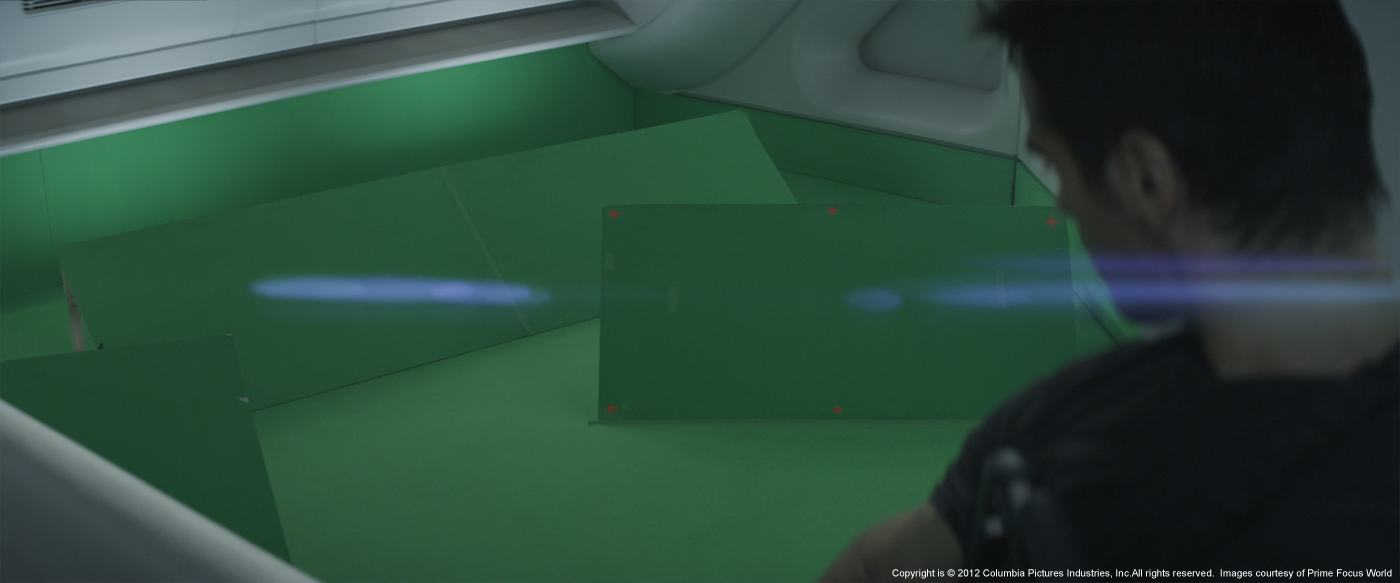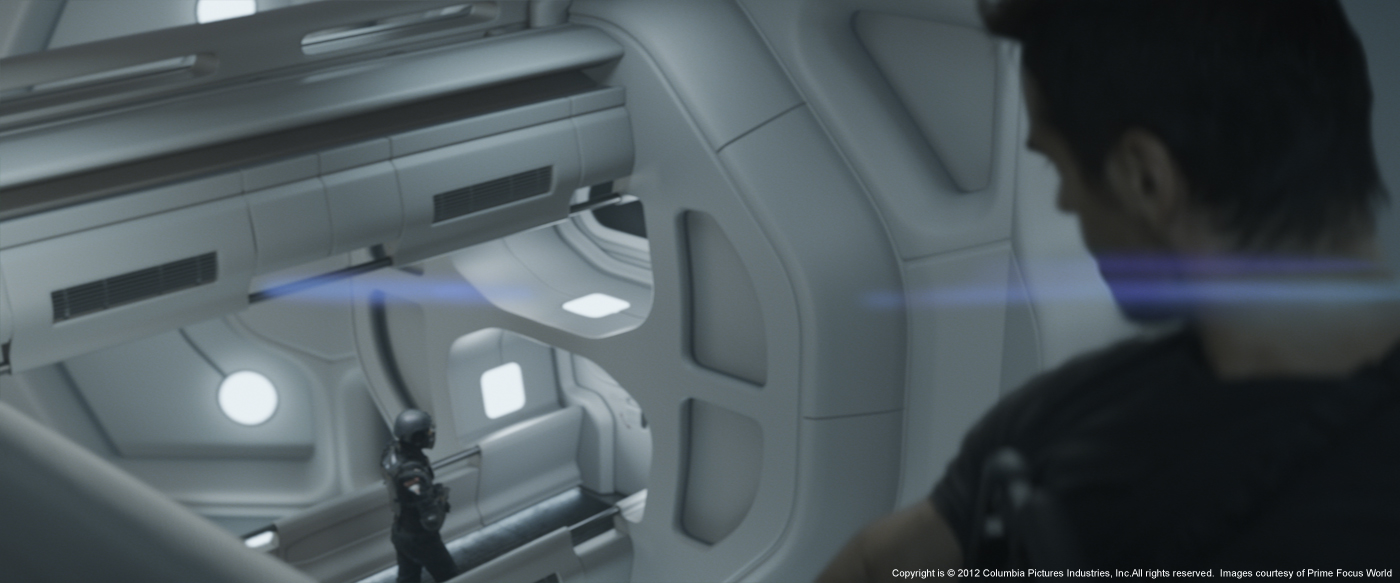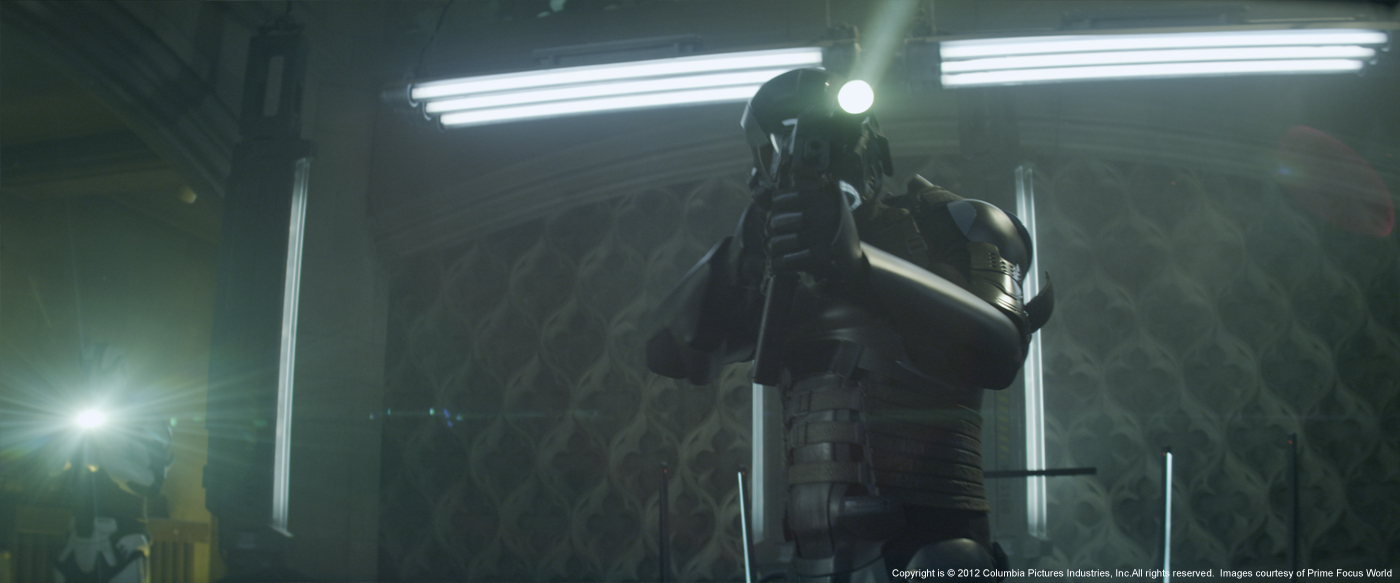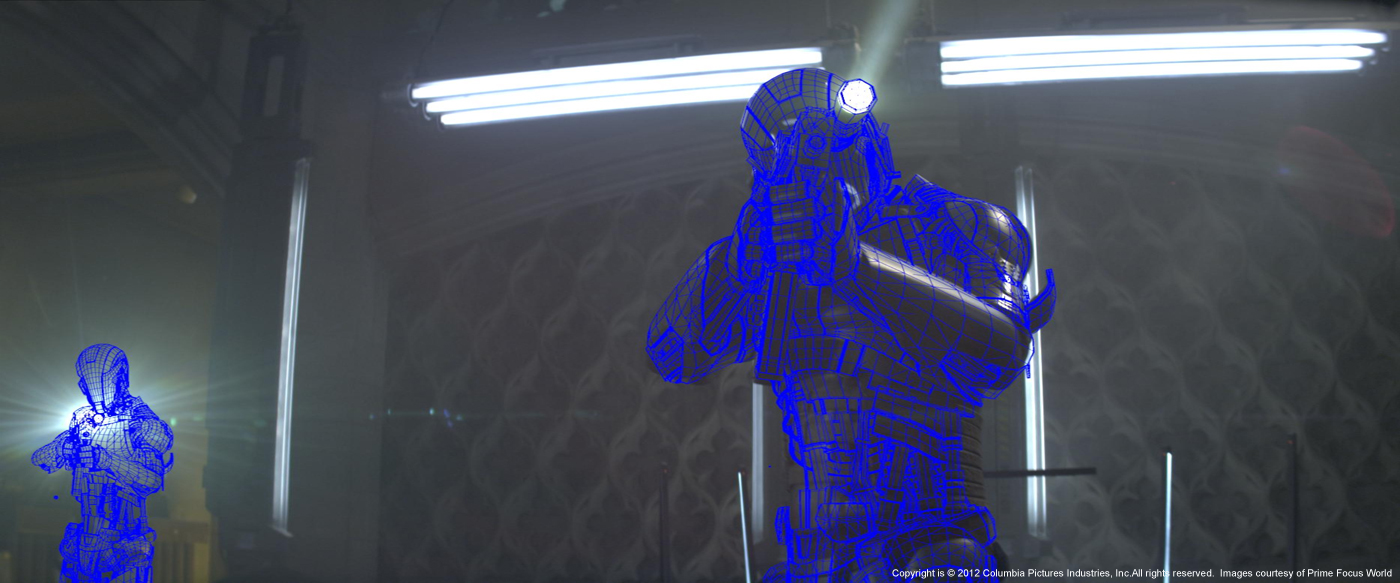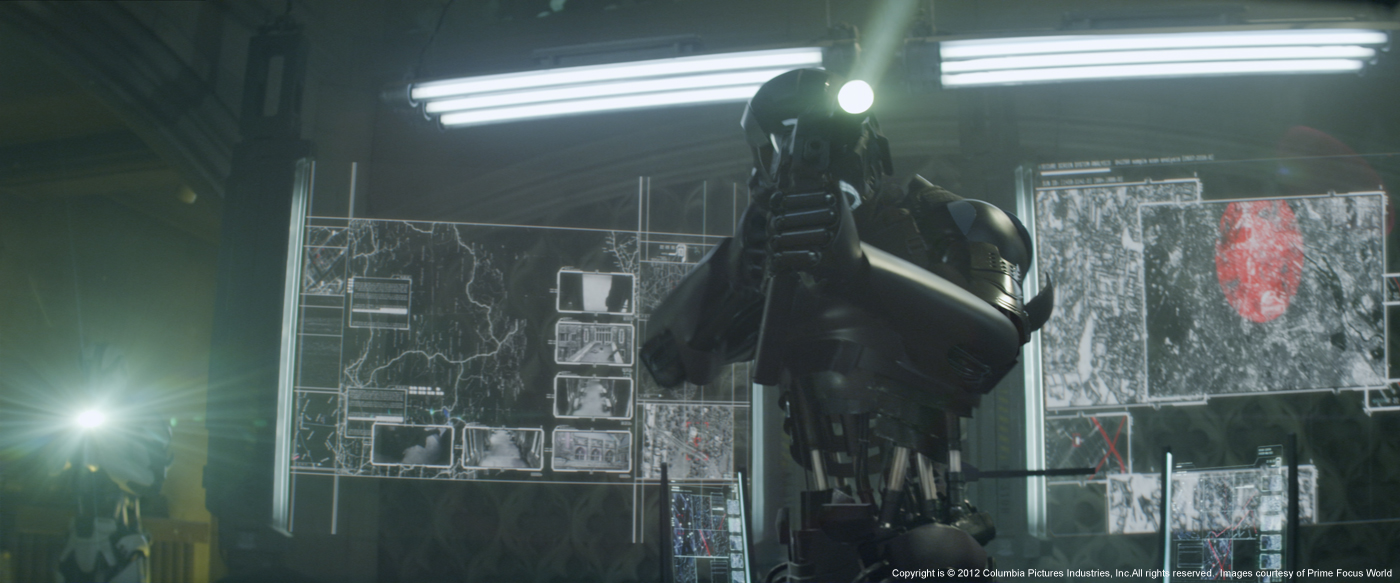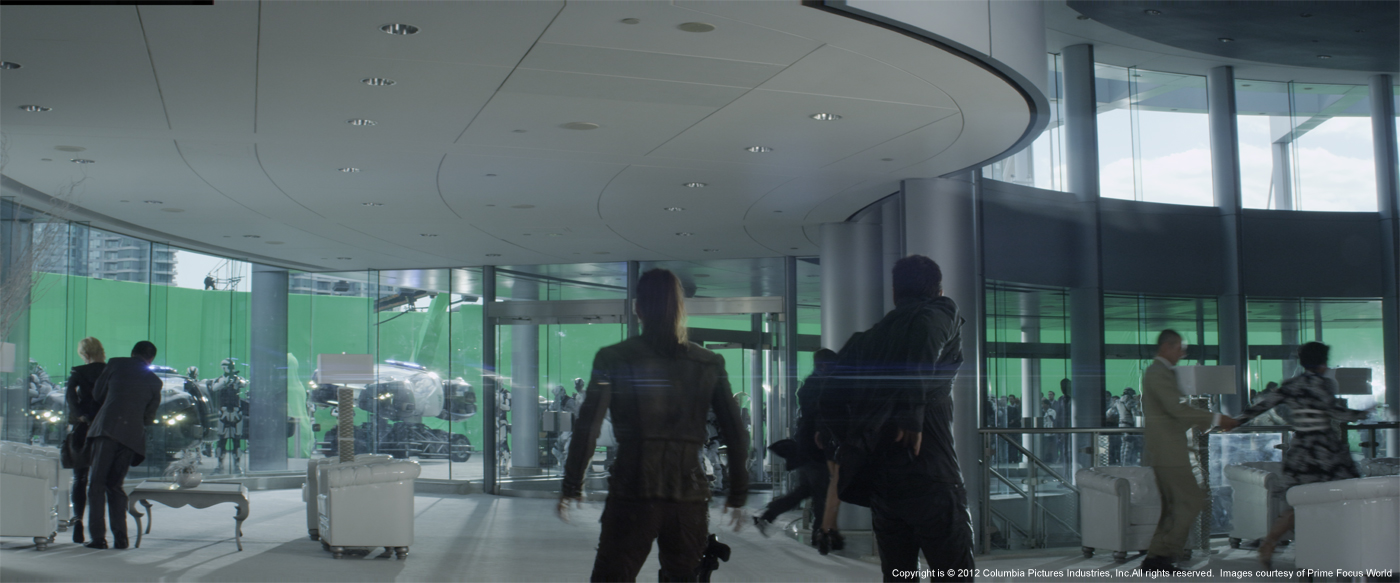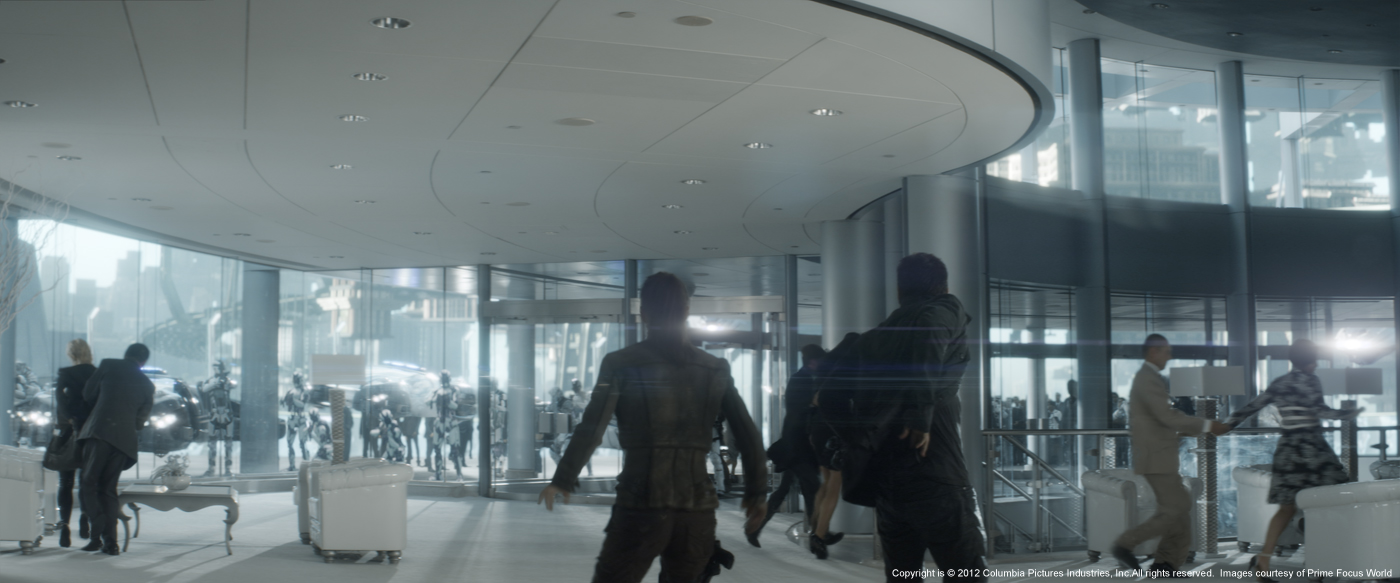Aleksandar Pejic has worked for many years at Double Negative and particularly on films such as BATMAN BEGINS, CHILDREN OF MEN, THE DARK KNIGHT or INCEPTION. He then joined Prime Focus and supervises the effects of TOTAL RECALL.
What is your background?
I have degrees in Architecture and Civil Engineering, and a Masters in Computer Imaging. My first contact with 3D was through Architectural and Engineering studies where we used AutoCad for technical drawings. Very quickly my interest expanded into 3D, where I started playing with Alias Wavefront and what was 3D Studio at the time. After I spent some time teaching myself 3D I ended up working in Architectural visualisation and then commercials. When the first version of Maya came out back in ‘98 I remember everyone jumped on that train. At some point my life moved to London where I got my first job in the VFX industry. I spent many years working at Double Negative where I was lucky enough to work with and learn from some of the greatest supervisors in this business.
How did Prime Focus got involved on this show??
There are always many talks on different fronts when it comes to getting new projects you want to get involved in. We all regularly talk to studios, in this case it was Sony and at the same time we knew TOTAL RECALL was in town. At some point we met for a coffee with the DNeg guys – I had worked with them for years and talked about a possible collaboration on this project. Within a couple of weeks we went through different sequences with VFX Supervisor Peter Chiang and VFX Producer Fay McConkey and agreed on several sequences we were all happy with. They covered all sorts of different VFX work.
How was the collaboration with director Len Wiseman??
DNeg was fronting all the VFX work and our main contact was through the VFX Supervisors Peter Chiang and Paul Riddle. In the last couple of months, once we got most of the shots to a presentable level for Len, we had nightly review sessions, with Len being in LA and Peter, Paul and my PFW team in London. Depending on how much we had to present, Len would look at the shots and give his feedback. Len’s feedback was extraordinarily visual and creative and it was always extremely clear where he wanted to go next.
Can you tell us more about your collaboration with Production VFX Supervisors Peter Chiang and Paul Riddle?
On shows like this you end up working with people who have done it so many times and they know the work and what needs to be done inside out.?I had the pleasure of working with VFX Producer Monette Dubin on INCEPTION by Chris Nolan, and this felt like we just carried on where we left it last time. Monette was based in LA with Len, while Fay was based in London, so having both of them in two different time zones you get 24h service. Having that previously established relationship with Peter & Paul made it really smooth and easy for us at Prime Focus. One of the most important aspects of this job is to be able to understand the vision of your Supervisors when it comes to creative challenges. We mainly worked with Paul on a day-to-day basis, and as we got closer to delivery both Peter and Paul were extensively involved in giving us feedback and creative direction for our work.
What have you done on this show??
Prime Focus World delivered 399 shots. “Synth” robotic soldier shots accounted for 224 of those shots, and the Zero G “China Falls” sequence comprised 86 shots. The other key sequence which Prime Focus contributed was the “Lobby” sequence, which required extensive set-extension work and the addition of CG background elements such as flying harriers and crowd extension work.
Can you tell us more about the Synths creation and rigging?
DNeg gave us a high res model which we tweaked for the specific needs of matching live action stunt men in armour. The rigging was quite difficult because the design included many overlapping moving parts that were not designed to match human muscle structure, so as we went along we updated the rig many times with detailed tweak controls to account for the extremes of human joint orientation. We also implemented control sliders for the armour so that we could ‘float’ it off the skeleton to match the live action, blending between the skeletal joint animation and screen space position.
How did you manage the Synths lighting aspect?
All lighting was done in Guerilla, which is a hybrid Reyes / Raytrace renderer we have used in several productions now.?We tried different approaches for the Synths, with environment HDRI first, but we were not satisfied by the quality.?The reflection integration wasn’t spatially correct and it was too obvious.?Since we had the very accurate set used by the tracker,?we decided to try brute force reflections after a quick shading on the set.?After some tests, we noticed that the numbers of bounces required to light the interiors gave us huge render times. Finally we decided to bake the interior shading solution in a ptc and then raytrace the set.?It was the perfect solution for short render times and proper spatial reflections.?In terms of shading it was really classic, microfacet distribution and shlick approximation for fresnel.?For the diffusion contribution of the moving Synth we used brute force raytracing.?For the rest of the synths we pre-baked the environments on each Synth,?then convoluted it and raytraced it. It can look to be a heavy process but with Guerilla we had nodal tools that link everything dynamically. It was the most peaceful production that I ever worked on.
How did you work with Double Negative teams for the Synths?
The entire collaboration with DNeg was really seamless and not only for the Synths. All modelling and texturing was done by DNeg. They provided all assets, including turntable lookdev, which we ingested into our pipeline and matched to the level where the Synth just looks the same. What we did internally was our own shading and lighting. We were updating all elements till very last minute to match what DNeg did, so setting up an extremely flexible pipeline was the most beneficial thing we did at the beginning.
There is a wide shot of the Synths bay. How did you manage some many robots?
Our brief for the synth bay sequences was to replace the black body suits the actors wore on set with CG mechanical inner workings, whilst keeping as much of the live action armour as possible. Our main challenges were always going to be tracking the digital synths and matching the lighting as closely as possible to the plates for the most convincing integration of our CG.?On the lighting side, we tried various, more traditional approaches including image based lighting. It soon became apparent though that this was only going to get us so far – we needed far more detail in the reflections than the HDRI’s could give us and we also needed the flexibility to change the lighting set-ups between shots.?In the end, we decided to ray-trace all our reflections and only use the HDRI’s for any ambient contribution. In order to achieve this, we created a basic model of the set from a supplied Lidar scan. We then projected HDR textures taken on-set onto the model. Next we separated out the various light-emitting geometry so that we could tweak their position and contributions on a shot-by-shot basis. Finally we set-up additional interactive lighting passes for muzzle flashes and gun torches as additive effects that the compositors could dial in as and when required.
Can you tell us more about the zero gravity shots in the Fall?
The main challenge with the wire removal on the China Falls sequence was the number of wires and their resulting shadows, which had to be removed in an environment where the cameras and lighting were constantly changing. The software used was exclusively Nukex and Silhouette. As all shots required tracking for set extension, bullet hits and CG, we had cameras provided by our matchmove department. They also gave us scene geo. The first task was to remove the wires from the background by projecting patches onto this geo and using various tranforms to lock the patches into place. They then required extensive grading due to the ever-changing lighting. We used the Nuke curve tool linked by expressions to grade nodes. This helped to match the flickering luminosity of the shots. The next challenge was removing wires off the actors. This involved warping and morphing clothing and skin patches to match the costumes. Certain areas that could not be patched (like when wires were over moving faces/hands), were given over to our excellent Silhouette painters. They frame by frame painted out the remaining wires. The final task was to remove Jessica Biel’s hair bun so a CG ponytail could be added in comp to help emulate the ‘Zero G’ effect. This involved everything from BG recreation to full ‘crown’ replacement. Once the paint and compositing was finalised many shots were given a Kronos retime to accentuate the feeling of weightlessness.
Did you need to recreate elements in CG for these shots?
With all the heavy wires removed, we were left with very little background in the plate, so we ended up doing extensive set extension. Some of it was done through re-projection in Nuke and some of it full CG. Lighting was beautifully done on set and very tricky to match in CG, but the guys did a tremendous job. The set extension we did varied from just a wall in the background to full CG shots. Another challenge in this sequence was the pony tail. After talking to Peter Chiang he suggested we try an element shoot with the pony tail in a water tank against blue screen. We did the shoot at Shepperton Studios with the guys from DNeg, who were shooting other elements for their work. We choreographed every shot so that we could minimize the amount of 2D warping in the comp. There were a few shots where we knew we were going to have to do a full CG pony tail to allow Len and Peter creative freedom. The simulation was all done in Houdini and rendered in Guerilla.?From other CG elements we ended up with all of the floating props, including guns, bags, bullets, etc.
What was the real size of the Lobby sequence set and how did you extend it?
The live action interior was about 100 feet across, and then another 60 feet of concrete balcony beyond the windows to the green screen. The balcony railings were textured and rendered as 3D objects in Nuke. Our CG freeway with Massive sim cars was another 900 feet beyond the balcony, and rendered in Guerilla. The rest of the CG city background was given to us by DNeg as obj and prelit renders which we projected in Nuke, and matte paintings for the far distance.
How did you create the crowd??
There were two different « crowds » we created for the Lobby sequence. One was additional Synths – the other was the rest of the crowd in the background. Synths were in this case full CG renders posed to work with the shots. We created a huge library of different pose renders as a turntable so compositors were able to pick the frame and pose they liked and address any creative changes with minimal time required. As for the crowd, we used 2D elements shot against green screen provided by DNeg. The challenge on that one was to get the element working with rest of the action in the crowd.
Can you tell us more about the various CG elements in this sequence?
The Lobby sequence looked at the beginning as something straight-forward, but it turned out to be the most creatively challenging work we faced. As you noticed, the size and scale was one of the biggest issues we fought for weeks. All background elements were provided by DNeg. They rendered the background buildings as turntables and we projected them onto the cards in Nuke. Some of the elements just couldn’t work with the camera move so we had to go back to creating simplified 3D geometry and then project it back on in order to see parallax between objects. The biggest challenge was actually the look, and this is where we worked really closely with Peter and Paul. For the other CG elements we created full CG Harriers and additional set extensions including balcony extensions, CG traffic and freeway, additional pros, etc.
What was the biggest challenge on this project and how did you achieve it?
The biggest challenge was getting correctly tracked and aesthetically pleasing Synth movement. The stuntmen were all proportioned differently, the armour was not always placed on their bodies in the same relative position, it was floating on their flesh rather than bolted to a robot skeleton, and some of the armour seemed to be made of rubber and would flex as they walked. To solve these issues, we would sometimes object-track parts of the armour and derive the skeletal animation from screen space, but when they were walking we had to get correct animation from the ground up and work the track out to the surface.
Was there a shot or a sequence that prevented you from sleep??
I would consider myself very lucky if it was just one shot or sequence. There were a few of them on TOTAL RECALL, but all that goes into our job description so doesn’t really count. Rendering the SynthBay with 20+ Synth in it had a few of those that kept me awake into the early morning.
What do you keep from this experience???
What we learnt on TOTAL RECALL, from working very closely with other VFX houses and sharing assets, is the importance of having a really robust and flexible pipeline, so that you can tweak it to easily match other companies workflows. Also, as we were working across three Prime Focus facilities (London, Vancouver, Mumbai) we further refined our internal management processes. There is always space for improvement on a project, otherwise this job would be very boring. There are a few things we learnt for next time, and we’re already working on them – mainly in-house tools for tracking data and moving assets around the world that allow the global Prime Focus VFX team to work seamlessly, like we are all in the same building.
How long have you worked on this film?
We got involved mid / end of January and delivered the last shots including some DI mattes on 6th July. That was all for the cinema release. As addition to that we delivered around 40 shots for the extended Blu-ray version on 2nd of August.
What was the size of your team?
It was around 130 artists including comp, prep and paint , tracking, lighting …
What is your next project??
There are a number of other projects going on at the moment at Prime Focus. The one I’m involved in will be announced within days as it’s still in development so let touch base again soon. All I can say is its big, exciting and challenging with a well-known director.
What are the four movies that gave you the passion for cinema?
The list is really long. I was a big fan of sci-fi movies, so if we are talking about VFX movies – the ones that got me interested, or rather fascinated, with the VFX world – here are my top 4:
1) BLADE RUNNER?, 2) ALIEN?, 3) THE ABYSS?, 4) STAR WARS
A big thanks for your time.
// WANT TO KNOW MORE?
– Prime Focus World: Dedicated page about TOTAL RECALL on Prime Focus World website.
// TOTAL RECALL – PRIME FOCUS THANK YOU LIST
Kate Adams
Pranay Agarwal
Ole Alexsander Nordby
Terence Alvares
Jaroslaw Ancuta
Chris Arnott
Kashif Arshad
Atal Bachani
Abu Bakar
Justin Ball
Jared Barber
Craig Bardsley
Bart Barendregt
Reuben Barkataki
Branko Basaravski
Romain Bayle
Kieran Belshaw
Ann-Marie Blommaert
Ilona Blyth
Robinson Boomiyar
Zak Boumediane
Jon Bragado
Andre Brizard
Cuco Bures
Marc Calvelo
Francesco Capone
Mickael Caramelo
Juan Carlos Mendoza
Alexis Casas
Sarah Cauchois
Chris Chadwick
Rachid Chikh
Nick Chong
Corey Coates
Emma Cooper
Christopher Courtland
Jon Cowley
Shome Dasgupta
Bryan Davies
Michael Davis
Vincent Dedun
Stephane Deverly
Ryan Delaney
Guliz Demiray
Olivier Derpierre
George Douglas
Paul Ducker
Claire Duthie
Michael Eames
Andrew Emerson
Shayne Farrier
Dennis Fechner
Matt Fidler
Brody Fikkert
Daniel Forgacs
Neville Freitas
Aron Galabuzi
Attila Gall
Sarah Gatefield
Shivesh Gehlot
Justas Giedraitis
Frederikke Glick
Ricardo Gomez
Alex Goodfellow
Mai Gray
Michael Grobe
Vivien Guiraud
Shyam Gurumoorthy
Rob Hall
Chris Hardman
Lionel Heath
Martin Hobbs
Victoria Hodson
Francois Hoehl
Matt Hughes
Vili Ivanov
Kundan Jha
Abhishek Joshi
Marc Jouveneau
Pavel Kacerle
Gregory Kalaintzis
Vishal Kapoor
Tim Keene
Gary Kelly
Prajakta Khatal
Nick King
Connor Kitto
Jakub Krompolc
Ajesh KT
Pavan Kumar
Emmanuel Lange
Stuart Lashley
Andrew Lawson
Ben Legross
Bruno Lesieur
Benoit Leveau
Asha Lillian Joseph
Alex Llewellyn
Kier Longden
Jessica Lowrey
Sophie Luto
Heather MacPhee Ryan
Philip Maddock
Dhanjee Maheshwari
Pranav Malasi
Giorgio Marino
Melanie Martin
Cambell McLeay
Dan Mcrae
Neil Miller
Rebecca Miller
Ryan Mintenko
Carlos Miras Sepulveda
Matt Mitchell
Udit Mohan
Snehal Mohapatra
Sandrine Moniez
Andrew Mulligan
Torsten Neuendorf
Daniel Newlands
Aswini Nimje
Cian O’Laoi
Fraehan Pagdiwalla
Kunal Patankar
Alexandre Pavot
Alex Pejic
Miriam Pepper
Menelaos Peristeridis
Diego Piccinato
Cyril Pilchard
Olivier Puechberty
Vivek Pundir
Marko Radinkovic
Sinisa Radosavljevic
Dan Rankin
Venkata Reddy
Tom Richardson
Alessandro Righi
Stephen Robertson
AngelGil Ruiz
Jasdip Sagar
Sromona Saha
Amey Sakpal
Alessandro Salis
Jorge Sanchez
Raphael Santos
Gabriel dos Santos Blanco
Jeremy Seguin
Felix Serwir
Nidhi Seth
Jimit Sha
Imran Shafique
Vivek Sharma
David Shere
Shervin Shoghian
Avdesh Shukla
Sidharth Sinah
Richard Sowerby
Lee Sullivan
Junaid Syed
Abu Thahir
Ben Thomas
Neville Thomason
Joel Thompson
Andrew Thompson
Vipin Tripati
Donald Tse
Eric Tsui
Pan Vafeiadis
Janis Vaitilivics
Charlotte White
Stephen Willey
Yi Yang
Salvador Zalvidea
Tong Zhou
© Vincent Frei – The Art of VFX – 2012


